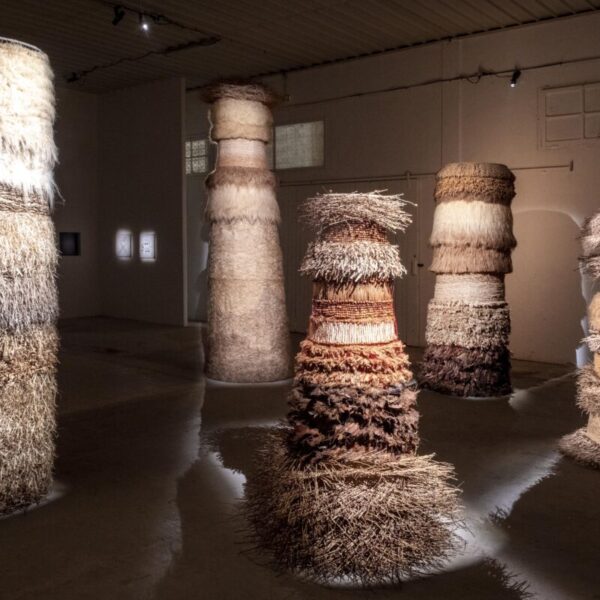In Gabès, in southern Tunisia, the plastic artist Mohamed Amine Hamouda, 44 years old, regenerates the coastal oasis, unique in Africa, through art made from palm grove waste. For him, this is not an ecological alternative, but a necessity in the face of local environmental degradation.
In Gabès, for years, associations have been raising awareness about the pollution problem linked to the Tunisian Chemical Group (GCT) located along the coast. This is the case for the Stop Pollution movement, made up of environmental activists, as well as the association Danseurs citoyens sud, which raises environmental awareness through dance. The chemical plant they are fighting against transforms phosphate into phosphoric acid and fertilizers for export, and has become a symbol of the city's ills. Respiratory problems, cancers, air and water pollution...: the residents describe this industrial complex as the plague of the city, responsible for 95% of urban air pollution.
But as a provider of jobs and the main economic resource, it seems unassailable. So, Mohamed Amine Hamouda has chosen to engage differently for the preservation of his city's environment.
This artist, born in Gabès, attended the local School of Arts and Crafts before becoming interested in the raw materials at his disposal: mainly the plants that grew in the palm grove. “I knew nothing about weaving, dyeing, or plants, but I knew it was part of our heritage. So I started to research and design how I could use it in my artistic production,” he explains.
An Exceptional Maritime Oasis
The maritime oasis of Gabès covers about 700 hectares. It constitutes a natural treasure, as it is one of the only - and among the last in the world - to open onto the waterfront and draw its ecosystem from sandy soils and marine air. Unique in the Mediterranean, it is renowned for its variety of date palms.
“Unlike the Bedouin populations or those living near the desert, we literally live in an oasis. Others live next to it and mainly use it for agricultural needs. For us, the oasis is part of our daily life,” specifies Mohamed Amine Hamouda.
In his workshop in Gabès, the smells of madder, corete, and plant glue overwhelm the visitor. The place resembles more a mad scientist's laboratory, with plant fibers hanging to dry in the windows and remnants of palm leaves scattered everywhere. The artist works with all the waste and plants found on site, which he uses as material for his sculptures.
One of his works, “Nar et Jommar” (Fire and heart of palm), takes the form of giant totems made from palm leaf remnants. It reflects the threats facing the area: pollution, the gradual extinction of biodiversity, and the marine ecosystem severely affected by the discharges into the sea from the industrial group.
The existence of the oasis is also victim to urbanization and land fragmentation, as well as the drying up of freshwater sources and extreme soil salinization. Mohamed Amine's totems represent the chimneys from which toxic fumes have been escaping for decades.
Restoring Traditions
In addition to this emblematic work that he has exhibited in Tunis and several countries (Morocco, Greece, Turkey, Germany, Kuwait), Mohamed Amine Hamouda is trying to restore some local traditions such as “Raghata,” the solidarity among farmers during harvests or sowing.
“It’s an opportunity to help each other and celebrate the cereal season or the date season. But it is also part of the customs of the south,” the artist recounts. He has, for example, asked basket weavers to teach him the art of weaving or the production of mulberry silk.
“I am not just paying homage to ancient traditions or heritage. For me, it is also about questioning the artist on what his raw material will be in a future where resources become scarce. Should we return to natural pigments? To more raw materials?” he wonders. He has already started this approach by recovering everything he can within the oasis. “It’s a commitment, a return to origins, to self-sufficiency, to our sovereignty and also a resistance, made of struggle and perseverance against industrial threats. I discuss this with my students at the Fine Arts, I try to show them that an artist also has a role to play on the ecological level.” To this end, he has founded an entire ecological department that he has been directing for two years, the “No-Name Eco-Lab.”
His tapestries made of fibers, palm leaves, halfa, and wool adorned the walls of the Institut des Cultures d’Islam in Paris during the exhibition “The Spirit of Gesture” held this winter. Some are dyed with henna, another traditional local plant, with which Mohamed Amine experiments every day. He showcases this on his Instagram page, dedicated to his plural artistic approach: that of a self-taught alchemist, an environmental activist, and an artisan. “Today, my main goal is to raise awareness among young people because the relationship to pollution in Gabès has become normalized. Many have resigned themselves and no longer see the ecological threat it poses to our ecosystem,” he laments. “So with art, I would like to make them understand that the oasis is also our identity, and not just our place of life.”

Cover Photo: The totems symbolize the chimneys from which toxic fumes have been escaping for decades ©Nicolas fauqué
